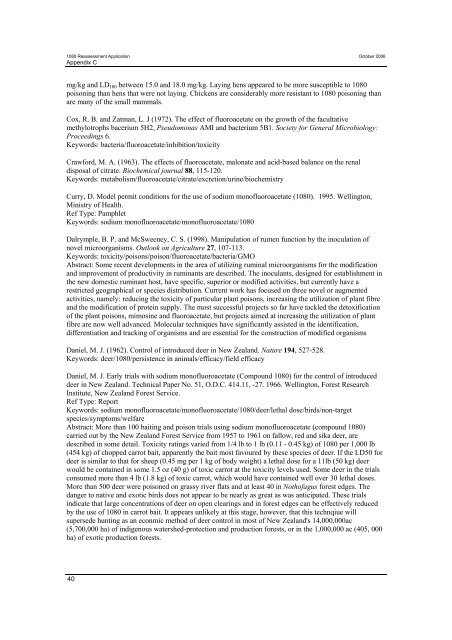Source: Landcare Research (1964). Control of poisons. Royal ...
Source: Landcare Research (1964). Control of poisons. Royal ...
Source: Landcare Research (1964). Control of poisons. Royal ...
Create successful ePaper yourself
Turn your PDF publications into a flip-book with our unique Google optimized e-Paper software.
1080 Reassessment Application October 2006<br />
Appendix C<br />
mg/kg and LD100 between 15.0 and 18.0 mg/kg. Laying hens appeared to be more susceptible to 1080<br />
poisoning than hens that were not laying. Chickens are considerably more resistant to 1080 poisoning than<br />
are many <strong>of</strong> the small mammals.<br />
Cox, R. B. and Zatman, L. J (1972). The effect <strong>of</strong> fluoroacetate on the growth <strong>of</strong> the facultative<br />
methylotrophs bacerium 5H2, Pseudomonas AMI and bacterium 5B1. Society for General Microbiology:<br />
Proceedings 6.<br />
Keywords: bacteria/fluoroacetate/inhibition/toxicity<br />
Crawford, M. A. (1963). The effects <strong>of</strong> fluoroacetate, malonate and acid-based balance on the renal<br />
disposal <strong>of</strong> citrate. Biochemical journal 88, 115-120.<br />
Keywords: metabolism/fluoroacetate/citrate/excretion/urine/biochemistry<br />
Curry, D. Model permit conditions for the use <strong>of</strong> sodium mon<strong>of</strong>luoroacetate (1080). 1995. Wellington,<br />
Ministry <strong>of</strong> Health.<br />
Ref Type: Pamphlet<br />
Keywords: sodium mon<strong>of</strong>luoroacetate/mon<strong>of</strong>luoroacetate/1080<br />
Dalrymple, B. P. and McSweeney, C. S. (1998). Manipulation <strong>of</strong> rumen function by the inoculation <strong>of</strong><br />
novel microorganisms. Outlook on Agriculture 27, 107-113.<br />
Keywords: toxicity/<strong>poisons</strong>/poison/fluoroacetate/bacteria/GMO<br />
Abstract: Some recent developments in the area <strong>of</strong> utilizing ruminal microorganisms for the modification<br />
and improvement <strong>of</strong> productivity in ruminants are described. The inoculants, designed for establishment in<br />
the new domestic ruminant host, have specific, superior or modified activities, but currently have a<br />
restricted geographical or species distribution. Current work has focused on three novel or augmented<br />
activities, namely: reducing the toxicity <strong>of</strong> particular plant <strong>poisons</strong>, increasing the utilization <strong>of</strong> plant fibre<br />
and the modification <strong>of</strong> protein supply. The most successful projects so far have tackled the detoxification<br />
<strong>of</strong> the plant <strong>poisons</strong>, mimosine and fluoroacetate, but projects aimed at increasing the utilization <strong>of</strong> plant<br />
fibre are now well advanced. Molecular techniques have significantly assisted in the identification,<br />
differentiation and tracking <strong>of</strong> organisms and are essential for the construction <strong>of</strong> modified organisms<br />
Daniel, M. J. (1962). <strong>Control</strong> <strong>of</strong> introduced deer in New Zealand. Nature 194, 527-528.<br />
Keywords: deer/1080/persistence in animals/efficacy/field efficacy<br />
Daniel, M. J. Early trials with sodium mon<strong>of</strong>luoroacetate (Compound 1080) for the control <strong>of</strong> introduced<br />
deer in New Zealand. Technical Paper No. 51, O.D.C. 414.11, -27. 1966. Wellington, Forest <strong>Research</strong><br />
Institute, New Zealand Forest Service.<br />
Ref Type: Report<br />
Keywords: sodium mon<strong>of</strong>luoroacetate/mon<strong>of</strong>luoroacetate/1080/deer/lethal dose/birds/non-target<br />
species/symptoms/welfare<br />
Abstract: More than 100 baiting and poison trials using sodium mon<strong>of</strong>luoroacetate (compound 1080)<br />
carried out by the New Zealand Forest Service from 1957 to 1961 on fallow, red and sika deer, are<br />
described in some detail. Toxicity ratings varied from 1/4 lb to 1 lb (0.11 - 0.45 kg) <strong>of</strong> 1080 per 1,000 lb<br />
(454 kg) <strong>of</strong> chopped carrot bait, apparently the bait most favoured by these species <strong>of</strong> deer. If the LD50 for<br />
deer is similar to that for sheep (0.45 mg per 1 kg <strong>of</strong> body weight) a lethal dose for a 11lb (50 kg) deer<br />
would be contained in some 1.5 oz (40 g) <strong>of</strong> toxic carrot at the toxicity levels used. Some deer in the trials<br />
consumed more than 4 lb (1.8 kg) <strong>of</strong> toxic carrot, which would have contained well over 30 lethal doses.<br />
More than 500 deer were poisoned on grassy river flats and at least 40 in Noth<strong>of</strong>agus forest edges. The<br />
danger to native and exotic birds does not appear to be nearly as great as was anticipated. These trials<br />
indicate that large concentrations <strong>of</strong> deer on open clearings and in forest edges can be effectively reduced<br />
by the use <strong>of</strong> 1080 in carrot bait. It appears unlikely at this stage, however, that this technqiue will<br />
supersede hunting as an econmic method <strong>of</strong> deer control in most <strong>of</strong> New Zealand's 14,000,000ac<br />
(5,700,000 ha) <strong>of</strong> indigenous watershed-protection and production forests, or in the 1,000,000 ac (405, 000<br />
ha) <strong>of</strong> exotic production forests.<br />
40








![Application for test certificate [pdf, 131kb]](https://img.yumpu.com/50666502/1/184x260/application-for-test-certificate-pdf-131kb.jpg?quality=85)








